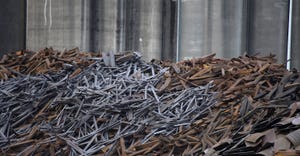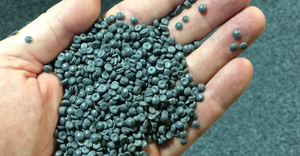Night And Day, Large-Scale System Keeps On Truckin' Trash
September 1, 1994
Paul B. Harder
One of the nation's largest trucking contracts is an often overlooked component of the Columbia Ridge regional landfill project in central Oregon. Not only is it generating mile, tonnage and dollar records for bulk hauler Jack Gray Transport (JGT) of Gary, Ind., it is also highlighting a new dimension of regional landfill operations: long-term, long-distance, heavy-duty gar-bage trucking.
The four-year-old contract, which will continue for at least another 16 years, calls for Jack Gray Transport to truck garbage from Portland, Ore., transfer stations to the Columbia Ridge landfill near Arlington in central Oregon.
Though it is only 153 miles from Portland to the landfill, JGT has used 45 trucks and 200 semi-trailers to log more than 28 million miles and move some 7 billion pounds of garbage. The haul along Interstate 84 through the scenic Columbia River Gorge runs 24 hours a day, five days a week.
JGT's contract with Metro, a re-gional government responsible for solid waste disposal for Multnomah, Clackamas and Washington counties (the greater Portland area), will peak at more than $208 million be-fore it expires in 2010. By that time, their fleet will have made more than 500,000 trips over 150 million miles and carried 26 billion pounds of gar-bage.
"Solid waste hauls like this will be common based on our success," ob-serves Division President and Gen-eral Manager Doug Coenen of Ore-gon Waste Systems (OWS), a sub- sidiary of Waste Management Inc. of North America that owns and operates the 2,000-acre landfill. "Other metropolitan areas and small communities are looking at what we're doing here as a possible solution to their own increasingly difficult solid waste problems," he said.
In winning this contract, JGT surprised many who believed that mainline rail and river barge systems, whose routes along the Columbia River parallel I-84, would be cheaper. As it turned out, JGT's bid of $12.30 per ton was 9 percent lower than rail (Union Pacific), 22 percent lower than river barge (Knappton Corp.) and 15 percent lower than Metro's estimate.
Garbage also is delivered to the Columbia Ridge landfill by the trainload from Seattle, 320 miles to the north. Washington Waste Systems, another Waste Management Inc. subsidiary that is under contract to transport and dispose waste for the city of Seattle, moves compacted gar-bage in modified marine shipping containers from transfer stations to a Union Pacific (UP) intermodal rail yard in Seattle. Up to 140 containers are then loaded onto Greenbrier/ Gunderson double-stack well cars for transport to the Columbia Ridge landfill.
Seventy-car trains make the 320-mile trip to Columbia Ridge on alternate days three times a week, traveling south to Portland, then by the UP mainline to the OWS intermodal rail yard at the Columbia Ridge landfill.
Jack Gray Transport's 20-year garbage haul contract gave engineers and equipment managers confidence in specifying the trucks and trailers - after all, they will move identical loads over the same 153-mile route some 500,000 times. On-highway reliability dominated their equipment decisions, in part due to the public anxiety about trucking garbage through the Columbia River Gorge, which is a National Scenic Route. Also, Jack Gray Transport is contractually required to maintain the flow of garbage from Port-land to Arlington.
Preventive Maintenance To come out ahead on their contract, the company's trucks need al-most faultless performance for 150 million miles. Garbage is picked up at two Portland area transfer stations, where 7-by-7-by-39-foot slugs of waste weighing up to 32 tons are extruded by Amfab Transpac compactors into 200 Fruehauf trailers.
The 48-foot, enclosed semi-trailers are built to withstand the wear of the heavy, abrasive slugs as they are forced in and out of the trailers during loading and unloading. To eliminate leaks and gain internal wear protection, Lifelast urethane, a coating developed by K&B Coatings of Vancouver, Wash., is applied. The 65-foot truck-trailer combinations travel on seven axles, including Van Raden air suspension drop/push axles under the trucks and trailers.
The company uses Standard Peterbilt 378 three-axle conventionals with a 262-inch wheel base, plus a drop axle. Truck/trailer combos are licensed for 96,000 pounds, but since the weight of the garbage slugs is maintained at an average 29.5 tons, the loaded rigs typically have a gross vehicle weight of less than 93,000 pounds, re-portedly eliminating highway overweight citations.
Engines in the first 45 trucks were 425-hp Cat 3406C ATAAC mechanical diesels. The new Peterbilts that are now beginning to replace 500,000-mile veterans of the original fleet have Cat's electronic 3406-rated 435-hp with 1,650 pounds per foot of torque. They drive through Fuller Super 10 transmissions and Rockwell 3.90 rearends.
This power and gearing combination helps move heavy loads at 55 mph with an engine speed of 1,450 rpm. Another important feature with truck/trailer combos that run near maximum weight is this engine's pound-per-hp ratio of less than 6.6.
High-torque, low-rpm driving is taught in a driver training program jointly developed by Cat and JGT. Drivers observe a dramatic drop in fuel consumption that occurs when identical trucks run the route under the traditional shift-down, rev-up technique, then change to high-gear low-rpm running. Even on I-84's modest grades, the differential is nearly a gallon a hill when engines are worked down to 1,200 rpm be-fore shifting.
JGT considers power train reliability more important than fuel savings. Low-rpm driving means slower piston travel, less bearing and cylinder wear and proportionately less chance of engine failure. JGT notes that they have experienced only two on-highway engine failures in 28 million miles: one caused when an engine lost a valve, the other when a hose clamp failed.
The company follows textbook preventive maintenance procedures on its fleet. Due to lube oil analysis and a 400,000-mile engine tear-down in-spection, JGT has stretched oil-change intervals from 12,000 to 21,000 miles.
The Columbia River Gorge Nation-al Scenic Route is a major attraction for motorists. Add a 200-trip-a-day garbage truck haul to this route and you have the makings of a major public relations headache for the trucker and the trucking industry.
However, a JGT representative ex-plains, "If you don't break down, don't have accidents, aren't pulled over by the cops, are considerate of other motorists and aren't spilling trash, you're not a problem."
Beyond these obvious tactics, the company's drivers and dispatchers are taught to aid other motorists in distress. Only one Jack Gray truck has been involved in an accident, when a passing car ricocheted off a guardrail, causing a turnover. There have been no spills and 81 un-planned highway stops in some 33,000 trips, 70 of which were due to tire problems.
When problems develop, JGT's dispatch center knows it almost instantly. Motorola's Spectra high-frequency FM radio grid with four frequencies and four mountain top repeaters spaced along the deep Columbia River gorge, covers every mile of the route. On cue from their cab radio screens, drivers switch frequencies as they travel between repeaters, never losing voice contact with the Arlington base. Driver check-ins allow dispatchers to keep tabs on highway speed and maintain the truck spacing that Metro and OWS need to eliminate equipment congestion at ends of the route.
Wheels In Motion Coordinating 45 trucks, 200 trailers and 58 drivers on two shifts for a three-hour haul requires a staging area off I-84 at Rufus, 41 miles away from the landfill. Staggered shifts start with a driver taking an empty trailer from JGT's landfill terminal to Portland, then returning with a loaded trailer only to Rufus.
There another empty trailer is picked up for return to Portland, and another loaded one is brought back to the landfill at shift end. Other drivers shuttle loaded and empty trailers between the landfill and Rufus. The Rufus staging area makes for efficient use of drivers in compliance with DOT driving regulation.
At the landfill, loaded trailers are dropped at JGT's terminal parking area where customized Capacity of Texas yard goats complete the gar-bage haul loop, shuttling loaded and empty trailers between the parking area and the landfill half a mile a-way. The goats are beefed-up versions of Capacity TJ6500T Trailer Jockeys with heavy frames, strong suspensions, tandem-drive axles and 220-hp Cat 3208T diesels driving through Allison MT643 automatic transmissions.
At the OWS intermodal rail yard adjacent to the landfill, two Taylor lift trucks unload the trains of garbage containers from Seattle. Here the loaded containers join the string of JGT truck/trailers entering the 600-acre landfill site, with five OWS highway tractors shuttling the Seattle containers to and from the landfill without switching the trailers to yard goats.
At the landfill, the loaded trailers are tipped at the face of the garbage modules by two Columbia Trailer 50-ton capacity tippers. Nor-mally stationary with electric-driven hydraulics, here they are mobilized on Cat-erpillar 235 excavator un-dercarriages and their hydraulics are powered with Cat 3208 and 3304 diesels. The two tippers can dump between 125 and 150 trailers in a nine-hour day (approximately 4,000 tons).
The Columbia Ridge Landfill will reach its capacity of approximately 60 million tons in about 50 years. Its waste module design consists of compacted clay, a high-density poly-ethylene membrane covered with a geotextile that is topped by a leach-ate collection system of washed gravel, perforated plastic drains, more geotextile fabric and a protective lay-er of at least one foot of sand and soil. Beneath it all is a pan lysimeter leak detection system (vadose zone monitoring). A methane gas extraction system will be installed as needed and seven wells will monitor groundwater around the site's peri-meter.
After garbage is tipped at the face of the modules, it is spread and re-compacted by two Cat D9N dozers and four Cat 826C compactors. By nightfall, an interim cover of at least six inches of dirt is spread over the compacted module by two Cat 637 push-pull scrapers which together move approximately 1,000 cubic yards a day. When a five-acre area of a module is brought to final grade, a low-permeability soil cap is spread and the area is contoured and re-vegetated.
Jack Gray representatives see the unusual size of their contract in terms of miles and tonnage as a precursor of a new niche for heavy highway trucking. Doug Coenen of OWS notes that large and small cities are observing this long-distance haul of compacted garbage as they seek solutions to their own garbage disposal problems. If Coenen's predictions are true, the unusual may be-come commonplace for both the waste disposal and trucking industries.
You May Also Like


